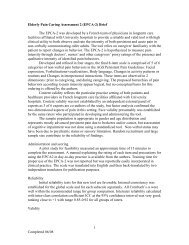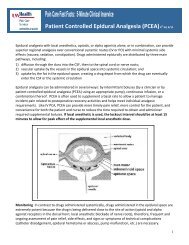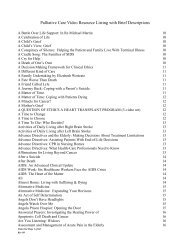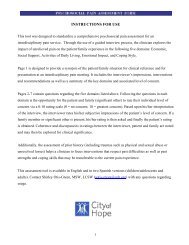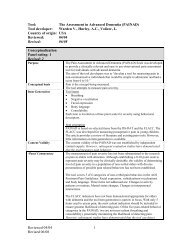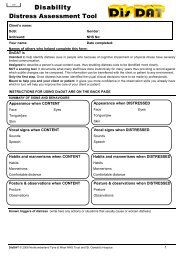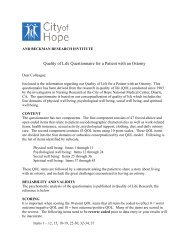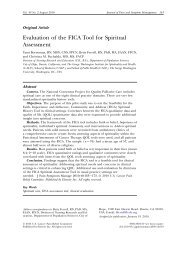Checklist of Nonverbal Pain Indicators (CNPI)
Checklist of Nonverbal Pain Indicators (CNPI)
Checklist of Nonverbal Pain Indicators (CNPI)
- No tags were found...
Create successful ePaper yourself
Turn your PDF publications into a flip-book with our unique Google optimized e-Paper software.
<strong>Pain</strong> at rest correlated weakly within the impaired group. According to thetool developer the tool is only valid for assessment <strong>of</strong> pain with movementConstruct validityThe data above demonstrate construct validity <strong>of</strong> the <strong>CNPI</strong> because higherscores were attained during periods <strong>of</strong> movement eliciting discomfort thanduring periods <strong>of</strong> rest.-Panel commentary Use <strong>of</strong> VDS with cognitively impaired individuals as a gold standard may beproblematic and contribute to lower correlation.Although the validity data is in the expected direction, testing with a morecognitively impaired sample is needed to assess tool sensitivity to detect pain.Summary <strong>of</strong> panel evaluation <strong>of</strong> pain assessment toolThe <strong>CNPI</strong> is a brief, clinically useful approach to assessing pain in elders with cognitive impairment. Itemsincluded in the scale are conceptually sound. Preliminary tool testing provides initial support for use <strong>of</strong> thetool at least with elders in acute care setting.The <strong>CNPI</strong> needs further evaluation to determine its usefulness with nonverbal elders including those in longterm care settings. Addition <strong>of</strong> items that consider more subtle behaviors or changes in behaviors orinteraction would improve comprehensiveness and ability to detect pain in those with less obviousbehavioral manifestations. Additionally, tool testing with males and minority samples is needed. Additionalevidence <strong>of</strong> reliability is needed, as well, particularly with use by staff nurses rather than trained geriatricnurse practitioners.Sources <strong>of</strong> evidenceFeldt, K. S. (1996). Treatment <strong>of</strong> pain in cognitively impaired versus cognitively intact post hipfractured elders. (Doctoral dissertation, University <strong>of</strong> Minnesota, 1996). Dissertation AbstractsInternational, 57-09B, 5574.Feldt, K. S. (2000). The <strong>Checklist</strong> <strong>of</strong> <strong>Nonverbal</strong> <strong>Pain</strong> <strong>Indicators</strong> (<strong>CNPI</strong>). <strong>Pain</strong> Management Nursing, 1(1),13-21.Feldt, K. S. (2000). Improving assessment and treatment <strong>of</strong> pain in cognitively impaired nursing homeresidents. Annals <strong>of</strong> Long Term Care, 8(9), 36-42.Key to panel rating3= Available evidence is strong2= Available evidence supports need for further testing1= Available evidence is insufficient and/or tool revisions are needed0= Evidence is absentEvaluation completed by:K. Herr, S. Decker, K. Bjoro, University <strong>of</strong> Iowa.Contact information: keela-herr@uiowa.eduCompleted 04/04 4




